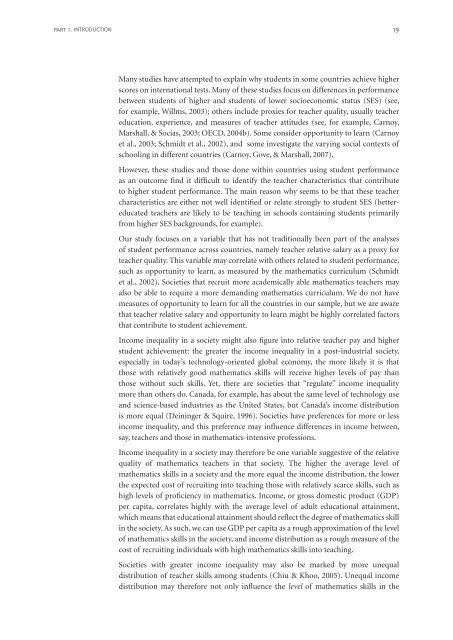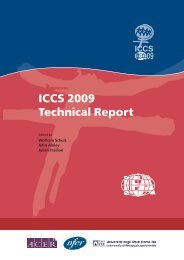Teacher Education and Development Study in Mathematics - IEA
Teacher Education and Development Study in Mathematics - IEA
Teacher Education and Development Study in Mathematics - IEA
Create successful ePaper yourself
Turn your PDF publications into a flip-book with our unique Google optimized e-Paper software.
PART 1: INTRODUCTION<br />
19<br />
Many studies have attempted to expla<strong>in</strong> why students <strong>in</strong> some countries achieve higher<br />
scores on <strong>in</strong>ternational tests. Many of these studies focus on differences <strong>in</strong> performance<br />
between students of higher <strong>and</strong> students of lower socioeconomic status (SES) (see,<br />
for example, Willms, 2003); others <strong>in</strong>clude proxies for teacher quality, usually teacher<br />
education, experience, <strong>and</strong> measures of teacher attitudes (see, for example, Carnoy,<br />
Marshall, & Socias, 2003; OECD, 2004b). Some consider opportunity to learn (Carnoy<br />
et al., 2003; Schmidt et al., 2002), <strong>and</strong> some <strong>in</strong>vestigate the vary<strong>in</strong>g social contexts of<br />
school<strong>in</strong>g <strong>in</strong> different countries (Carnoy, Gove, & Marshall, 2007).<br />
However, these studies <strong>and</strong> those done with<strong>in</strong> countries us<strong>in</strong>g student performance<br />
as an outcome f<strong>in</strong>d it difficult to identify the teacher characteristics that contribute<br />
to higher student performance. The ma<strong>in</strong> reason why seems to be that these teacher<br />
characteristics are either not well identified or relate strongly to student SES (bettereducated<br />
teachers are likely to be teach<strong>in</strong>g <strong>in</strong> schools conta<strong>in</strong><strong>in</strong>g students primarily<br />
from higher SES backgrounds, for example).<br />
Our study focuses on a variable that has not traditionally been part of the analyses<br />
of student performance across countries, namely teacher relative salary as a proxy for<br />
teacher quality. This variable may correlate with others related to student performance,<br />
such as opportunity to learn, as measured by the mathematics curriculum (Schmidt<br />
et al., 2002). Societies that recruit more academically able mathematics teachers may<br />
also be able to require a more dem<strong>and</strong><strong>in</strong>g mathematics curriculum. We do not have<br />
measures of opportunity to learn for all the countries <strong>in</strong> our sample, but we are aware<br />
that teacher relative salary <strong>and</strong> opportunity to learn might be highly correlated factors<br />
that contribute to student achievement.<br />
Income <strong>in</strong>equality <strong>in</strong> a society might also figure <strong>in</strong>to relative teacher pay <strong>and</strong> higher<br />
student achievement: the greater the <strong>in</strong>come <strong>in</strong>equality <strong>in</strong> a post-<strong>in</strong>dustrial society,<br />
especially <strong>in</strong> today’s technology-oriented global economy, the more likely it is that<br />
those with relatively good mathematics skills will receive higher levels of pay than<br />
those without such skills. Yet, there are societies that “regulate” <strong>in</strong>come <strong>in</strong>equality<br />
more than others do. Canada, for example, has about the same level of technology use<br />
<strong>and</strong> science-based <strong>in</strong>dustries as the United States, but Canada’s <strong>in</strong>come distribution<br />
is more equal (De<strong>in</strong><strong>in</strong>ger & Squire, 1996). Societies have preferences for more or less<br />
<strong>in</strong>come <strong>in</strong>equality, <strong>and</strong> this preference may <strong>in</strong>fluence differences <strong>in</strong> <strong>in</strong>come between,<br />
say, teachers <strong>and</strong> those <strong>in</strong> mathematics-<strong>in</strong>tensive professions.<br />
Income <strong>in</strong>equality <strong>in</strong> a society may therefore be one variable suggestive of the relative<br />
quality of mathematics teachers <strong>in</strong> that society. The higher the average level of<br />
mathematics skills <strong>in</strong> a society <strong>and</strong> the more equal the <strong>in</strong>come distribution, the lower<br />
the expected cost of recruit<strong>in</strong>g <strong>in</strong>to teach<strong>in</strong>g those with relatively scarce skills, such as<br />
high levels of proficiency <strong>in</strong> mathematics. Income, or gross domestic product (GDP)<br />
per capita, correlates highly with the average level of adult educational atta<strong>in</strong>ment,<br />
which means that educational atta<strong>in</strong>ment should reflect the degree of mathematics skill<br />
<strong>in</strong> the society. As such, we can use GDP per capita as a rough approximation of the level<br />
of mathematics skills <strong>in</strong> the society, <strong>and</strong> <strong>in</strong>come distribution as a rough measure of the<br />
cost of recruit<strong>in</strong>g <strong>in</strong>dividuals with high mathematics skills <strong>in</strong>to teach<strong>in</strong>g.<br />
Societies with greater <strong>in</strong>come <strong>in</strong>equality may also be marked by more unequal<br />
distribution of teacher skills among students (Chiu & Khoo, 2005). Unequal <strong>in</strong>come<br />
distribution may therefore not only <strong>in</strong>fluence the level of mathematics skills <strong>in</strong> the

















